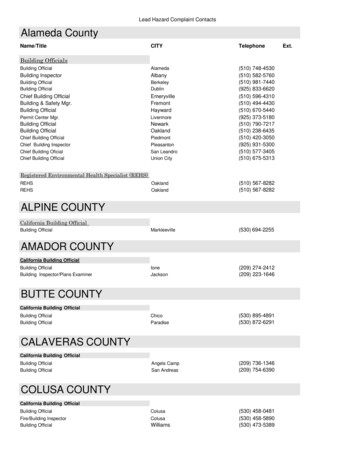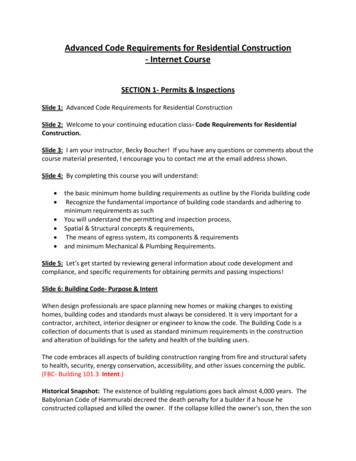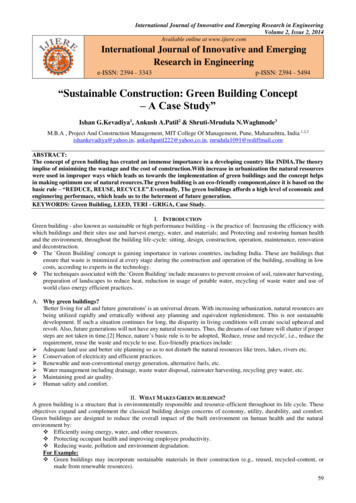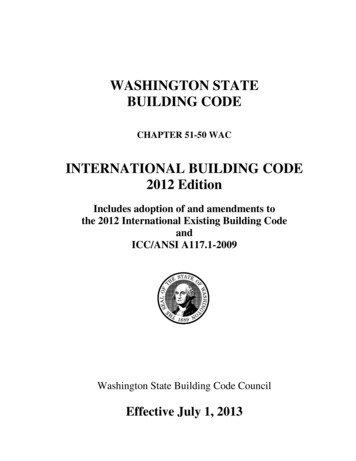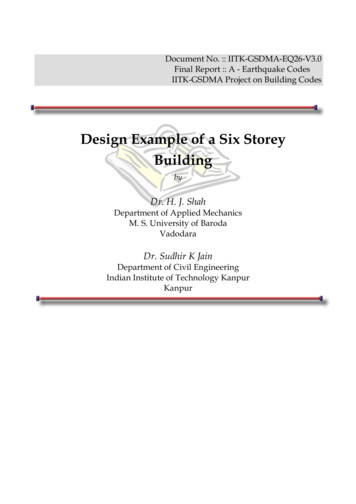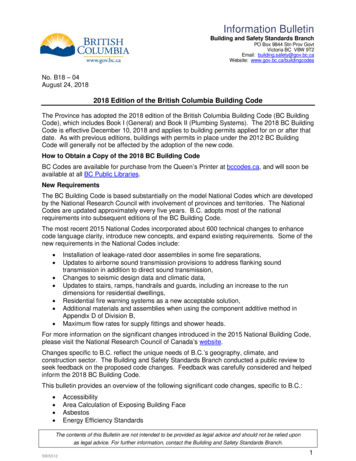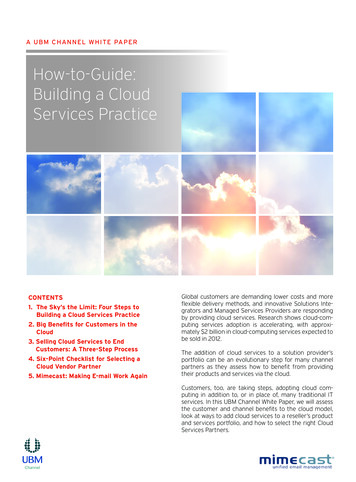
Transcription
A UBM CHANNEL WHITE PAPERHow-to-Guide:Building a CloudServices PracticeCONTENTS1. The Sky’s the Limit: Four Steps toBuilding a Cloud Services Practice2. Big Benefits for Customers in theCloud3. Selling Cloud Services to EndCustomers: A Three-Step Process4. Six-Point Checklist for Selecting aCloud Vendor Partner5. Mimecast: Making E-mail Work AgainGlobal customers are demanding lower costs and moreflexible delivery methods, and innovative Solutions Integrators and Managed Services Providers are respondingby providing cloud services. Research shows cloud-computing services adoption is accelerating, with approximately 2 billion in cloud-computing services expected tobe sold in 2012.The addition of cloud services to a solution provider’sportfolio can be an evolutionary step for many channelpartners as they assess how to benefit from providingtheir products and services via the cloud.Customers, too, are taking steps, adopting cloud computing in addition to, or in place of, many traditional ITservices. In this UBM Channel White Paper, we will assessthe customer and channel benefits to the cloud model,look at ways to add cloud services to a reseller’s productand services portfolio, and how to select the right CloudServices Partners.
A UB M C H AN N EL WH ITE PAPERThe Sky’s the Limit: Four Steps to Building aCloud Services PracticeToday’s most perceptive resellers are monitoring the cloud market and investigating ways to capitalize on what promises tobe a lucrative opportunity. Some resellers may wonder whether they need to launch their own cloud practices.Software as a Service (SaaS) offerings, hosted via a Cloud Vendor Partner, are among the most popular ways for resellers tobegin a cloud practice. Midsize businesses worldwide have already begun to embrace cloud solutions and, as security, privacyand recovery concerns are alleviated, enterprise customers are beginning to jump on the bandwagon as well.While more than half of end customers anticipate “the cloud” will account for nearly 13 percent of their IT spend this year, asurprising one-third of the solution providers questioned in a recent UBM Channel survey said their customers don’t see theopportunities that a cloud-based solution has to offer. Resellers that fail to see what their customers are already considering—if not budgeting for—may soon miss out on their piece of the cloud pie. The question resellers have to ask themselvesis how they can tap into the four “E’s” Examine, Evaluate, Expand and Entice—to help them build a successful cloud practice.1. Examine Your Current PortfolioTimes are changing. In the first half of 2010, nearly half(43 percent) of resellers’ solution delivery models weretraditional on-premise options, with only one-quarter of2010 revenue coming from off-premise hosted and purecloud sales combined.Today, those same respondents say they expect significantly more (38 percent) of their IT spend to be in offpremise sales by 2013, a 50 percent increase. So what arethese resellers going to be selling? How are they going toaccount for that increase? Questions like these are whatresellers have to resolve today in order to remain in business tomorrow.When resellers consider their current portfolio, there aretwo critical questions they should ask:1. Am I keeping pace with my competition with my current portfolio?2.Am I preparing myself today to compete in the cloudinclusive reselling landscape of tomorrow?If the answer to either question is “no” or “maybe,” it’stime to examine what’s being offered with a fresh eye.For decades now, the channel has embodied very clearrules of engagement based on a complex IT infrastructurerequiring extensive expertise to deliver. With increasingacceptance of the cloud, the way technology solutionshave traditionally been conceived, sold, delivered and supported is changing, and resellers have to change with it.2. Evaluate the Cost of Delivery and SupportFor resellers that haven’t examined their operations costslately, now is the perfect time to start. Many resellers—andeven corporate IT departments—are finding that they’recaught in the proverbial cycle of dedicating only about 20percent of their time to activities that can actually buildthe business, while spending 80 percent of their time justmaintaining the status quo.This is a perfect example of where a cloud practice canhelp resellers start anew. Imagine a fresh business modelwhere both reseller and customer enjoy easier softwareimplementations, faster upgrades and 24x7 uptime (whichtranslates to lower risk for all). Another critical consideration: Hosted solutions allow reseller and client to operatewith a leaner, more productive technical staff.In a cloud model, resellers can tap into the staff of anexperienced cloud provider, reduce their risk, control costsand increase the work their existing technical staff hastime to accomplish.3. Expand Your Services OfferingIt’s imperative that solution providers expand their offerings in order to fuel growth in 2012, something resellers clearly do understand. The majority of the resellersresponding to UBM Channel’s study said they are planningto expand their solution offerings into new, emerging technology areas. To add those capabilities, more than halfplan to form new strategic supplier partnerships, and overSolution Delivery Models 1H2010 (% of Revenue)UBM Channel previous research: Partner expects approximately 38% of IT spend off-premise by 2013On-premise product resale43.4%On-premise hosted18.6%Off-premise hostedPure cloudUnsure15.2%25% of Revenuesare Off-premise9.9%12.9%Source: UBM Channel
A UB M C H AN N EL WH ITE PAPER65 percent say they plan to offer cloud solutions.What these resellers are planning to do is tap into cloud sales,developing a cloud practice through a SaaS delivery model.In fact, providing Software-as-a-Service is by far the mostpopular way resellers are planning to break into the cloudresale market, with a full 40 percent of their cloud revenueexpected to come from SaaS sales alone this year. E-mailmanagement and disaster recovery in the cloud are twoenticing opportunities resellers are latching onto, thoughinfrastructure-as-a-service opportunities are also beginningto grow in importance and acceptance among end users,a trend sure to continue as concerns over security, pricingmodels and the capability of cloud providers fade.4. Entice Customers to Try the New ServiceThanks to the barrage of television, radio and print adsmaking “the cloud” sound like an illustrious travel destination, most customers are already familiar with the basicpremise of cloud computing. This makes it only natural forresellers to bring up cloud options in any discussion aboutsoftware and how critical applications can be deployed,accessed and supported.It is important to recognize, too, the ubiquitous natureof SaaS and how it’s already finding its way into clients’businesses with resellers’ help. Software-as-a-Service isgaining traction. Close to 80 percent of respondents to arecent InformationWeek survey say their companies areusing some form of SaaS, up from 61 percent just twoyears ago, with CRM and e-mail leading the charge.To find the magic words to entice customers to try a cloudservice such as SaaS, resellers need only to put themselves in the customer’s shoes. Clients want faster software deployments, less demand on their internal IT staffs,24x7 uptime, reduced risk, top-tier support and easierrenewal processes. Couple that with an OpEx (vs. CapEx)discussion and resellers will be on their way to launching acloud services practice that makes dollars as well as sense.Big Benefits for Customers in the CloudThere are three basic models of delivering cloud computing: Software-as-a-Service (SaaS), Platform-as-a-Service(PaaS) and Infrastructure-as-a-Service (IaaS). Each has arole in the delivery of services to end-user customers. Inaddition, each of these models represents regular, recurring revenue, which can be billed in accordance with customer or market demand.Cloud Computing ModelsWhen speaking with customers about the differencesbetween traditional delivery of software and softwaredelivered via cloud services, there are numerous benefitsthey should consider.3. IaaS refers to the infrastructure that supportseverything: servers, storage, networking, operatingsystems, databases and applications.1. SaaS refers to end-user software applications delivered over the Web.2. PaaS refers to the technologies and services forcoding and deploying SaaS applications quickly andefficiently.Traditional Software Delivery vs. Cloud ServicesTraditional SoftwareDeliveryCloud ServicesExplanationCapExOpExCost is shifted from high, up-front capital expenditures tolower, recurring operational expenditures.Higher costsGreater savingsForrester estimates that 75 percent of IT budgets arespent simply keeping the lights on—rather than beinginvested in innovation.One-time purchaseRegular, recurring revenue.A benefit to both customer and channel partner is thepredictable, recurring payments and revenue stream thatoccurs with the SaaS cloud-services model.Constant infrastructureupgrades“Pay-for-usage” modelInstead of the constant treadmill of hardware and software upgrades, customers pay for the services they need,when they need them.
A UB M C H AN N EL WH ITE PAPEROften decentralizedAlways centralizedSoftware is managed, deployed and upgraded from acentral location and made available via the Web.Device-dependentDevice independentThe application experience and all capabilities are delivered in the same way to all supported devices.Licensing agreementsNo long-term contractsUnlike traditional software delivery, SaaS can be deliveredas a month-to-month service.ComplexSimpleSoftware delivered via the cloud removes customers’ painand time involved in upgrades, patches and maintenance.Selling Cloud Services to End Customers:A Three-Step ProcessMaking money. At the end of the day, that’s the reason resellers sell technology and the reason end users buy it—to helptheir businesses make money. To effectively sell any technology solution, resellers need to start with the most basic premiseof making money, then walk backward, working their way to a deep understanding of the very specific business needs thatany technology is intended to resolve.Resellers say their customers would consider a cloud solution if it could help them with the following, according toa recent UBM Channel study: Risk avoidance: More than half of the survey’s resellerrespondents said business continuity and disaster recovery (BC/DR) concerns would play a factor in their customers’ decisions to deploy a cloud solution. Competitive Edge: Of nearly equal importance, thesurvey showed, was the desire to gain a competitive business edge and to increase computing capacity and business performance.Customer Drivers: Continuity, Competitive Advantage, Capacity, Reduce IT CAPEXProvide business continuityand disaster recoverry51.8%Increase computing capacityand business performance51.4%Reduce IT CAPEX in favor of operational expenceIt’s Time to ACT (Assess, Create, Transition)Once a reseller has defined what it is that’s driving theircustomer’s interest in the cloud—risk mitigation, creatinga business advantage or reducing costs, for example—it’stime to develop a sales strategy that speaks to that clientin a meaningful way. In short, it’s time to A-C-T.1. Assess the client’s needs: Start off by getting to knowthe client’s business well, understanding the problem thatneeds to be resolved, determining if the client’s businessand technical organization are ready for the cloud—and50.9%50.5%Control/improve profit marginsSolution can be accessed anywhere49.5%Limited requirement for internal IT suport48.2%Reduce implementation time47.3%Offload meintenance/scalability ofIT resources35.5%Add redundancy35.5%Customer lack of knowledge about IT systemsDiversify IT systems Expense Reduction: Doing these things, of course,costs money, and that is where cloud services can reallyshine. In fact, more than half of the resellers surveyed saidtheir customers would consider a cloud solution in orderto reduce expenses, trading a significant up-front capitalexpense (CapEx) for a much smaller, ongoing operationalexpense (OpEx).57.3%Provide competitive business advantage31.8%25%Source: UBM Channelonly then, when the cloud is a strong and justifiable option,recommending a cloud solution that makes both business and financial sense. Create a side-by-side total costof ownership comparison of two possible solutions—onetraditional, one cloud. The numbers will speak for themselves. CapEx vs. OpEx is a discussion sure to resonatewith customers, particularly with watchful CFOs keepinga close track on every expense.2. Create a blueprint for the project: Once the client hasagreed that the cloud is the right option, design a plan thatmakes sense for the client’s business and for its IT department. The cloud is not right for everyone, and every cloudopportunity may not be a perfect fit for every potentialcloud client. This is where a reseller’s value-add comes intoplay; a sale such as this requires a great deal of consulta-
A UB M C H AN N EL WH ITE PAPERtion and technical expertise. It is the reseller’s job to makerecommendations that take into account the client’s existing infrastructure, IT capabilities and business objectives.3. Transition the customer to the new platform: Fromactivating an account and provisioning server space in ahosted environment to customizing software or platformoptions that reside in the cloud, resellers must do whatever it takes to transition the client from where they wereto where they are going—and beyond. The reseller remainsaccountable for training and supporting the end user, aswell as for the quality of service being delivered and anyongoing maintenance not specifically assigned by an SLAto the cloud provider—including any patches or updatesthat need to be made.Keeping in touch with the client is the key to additionalsales down the road. To really deliver on the promiseof the cloud, resellers should periodically return to theassessment stage, and re-examine how the solution is performing for the client, searching for new ways to optimizeperformance and reduce costs. A-C-T is not a one-timeevent, but a continual opportunity to stay in front of theclient, assess and reassess their needs, and in doing so,learn about new up-selling opportunities.Six Point Checklist for Selecting a CloudVendor PartnerAs always, partnerships are the foundation of solid business. In fact, according to a recent UBM Channel study of channelpartners, in 2012 nearly 50 percent plan to expand their solutions offerings into new and emerging technology areas andmore than 25 percent plan to form new strategic supplier partnerships.Once a Solutions Integrator or Managed Services Provider has made the decision to offer cloud services to their customers—perhaps a related software application or one it has been reselling and deploying traditionally for years—it is time to reviewCloud Vendor Partners.Channel partners who sell or plan to sell cloud-computing services said that their top customer drivers were Continuity,Competition, Capacity and CapEx reduction, according to the UBM Channel study.There are other important channel-partner drivers as well. This checklist will help resellers in the selection of the partnerthat will best meet their needs as they make their move to building a cloud services practice.While there is no one-size-fits-all Cloud Vendor Partner, there are things to look for in a new partner. When choosing a CloudVendor Partner, make sure they provide the following:1. Lead generation and support in closing business—Channel partners are looking for Cloud Vendor Partnersthat can create the demand and funnel leads to them. Thiscan include Webinars held by a vendor that sends appropriate leads to regional or vertical partners. It can alsoinclude call center campaigns that result in hot leads forfollow-up contact. Look for a Cloud Vendor Partner thatfocuses on growing its clients’ businesses and protectstheir sales from competitors.2. Quality sales and marketing tools— A solid hostedapplication doesn’t sell itself. It takes marketing muscleand sales tools. Look for a Cloud Vendor Partner thatprovides the marketing outreach as well as the sales collateral—and sales training— necessary to support its clients’sales efforts. Marketing tools should be part of an ongoing awareness and conversion campaign, not just a singleone-time program.The Channel is Seeking New Partnership: Looking to Add Technologies/Solutions to Fuel Growth2011 Study: How likely is your company to implement each of the following business strategyin the next 12 months?Rated Extremely Likely/LikelyWill expand its solution offerings intonew emarging technology areas46.0%Will from new strategic supplierpartnership25.3%Will acquire other business to expandinto new emarging technology areas11.2%Will be sold because of past orexpected poof financial results4.2%Will replace most of it'scurrent commodity suppliers3.5%Source: UBM ChannelRated Extremely Unlikely/UnlikelyWill sold because of past orexpected poor financial results67.7%Will replace most of it'scurrent commodity suppliers58.6%Will acquire other business to expand intonew emarging technology ariasWill from new strategic supplier partnershipsWill expand its solution offerings intonew emarging technology areas46.4%15.1%8.9%Source: UBM Channel
A UB M C H AN N EL WH ITE PAPER3. Secure and compliant access— Today’s security- andcompliance-driven computing environment requiresthat off-premise application and data hosting in thecloud must be as trusted as an on-premise data center.Make sure the Cloud Service Provider under consideration can offer four key features: confidentiality, integrity, availability and control.4. Lower costs through improved productivity—Providing IT services often focuses on maintenance andsupport, rather than proactive technology recommendations that drive the bottom line. The benefit of the cloudservices model is that integrators can now deploy a cloudsolution once without the headache of maintenance andupgrades. This is a win-win for the integrator as well as theclient. Look for a Cloud Service Provider that focuses onproductivity gains for the integrator as well as the customer.5. 24 x 7 customer support— It’s not a win if the integrator has to be available around the clock when providinga cloud service. Look for a Cloud Service Provider that isfully staffed and able to provide the needed organizationto support customers when and where necessary—seamlessly and without difficult handoffs.6. Long-term services revenue— Support your currentcustomer offerings portfolio with a cloud services provider that adds greater long-term services revenue foryour business. Look for a provider that is dedicated tocreating a global partner community to support mutualcontinued growth. Ask about renewal rates for the applications the provider is hosting.Mimecast: Making E-mail Work AgainMimecast works with channel partners to take the pain out of handling their customers’ most important data: the information that passes through their e-mail systems. When we started out 10 years ago, we saw what others didn’t—thatwhile corporate e-mail was increasingly being used as the primary store for critical business information, it was alsobecoming more complex, fragmented, less reliable and ever more costly. What had started out as a simple businesstool was becoming hard to manage—and creating risk for businesses in the process.Today, we provide essential cloud services for Microsoft Exchange, eliminating customers’ complex e-mail challengesand making running corporate e-mail easy. By working with the Mimecast partner program, you can instantly expandyour portfolio with a set of cloud-based e-mail archiving, continuity and security services. Becoming a Mimecast partnerrequires no financial commitment or extensive training burden as we provide full sales and technical support while youtransition your customers to the Mimecast service.E-mail ContinuityMimecast delivers always-on, seamless e-mail availabilitythrough automatic service failover and failback in nearrealtime during planned or unplanned e-mail outages.Seamless integration with Microsoft Outlook, Webmail,and smartphones provides uninterrupted, policy-basede-mail and calendar services for office staff and remoteworkers. Using a series of geographically dispersed, highlysecure data centers, each with built-in safeguards to protect against individual device or media failure, Mimecastoffers 100 percent service availability SLA that satisfiesregulatory compliance while reducing security risks. Ifyour customer is an archive service subscriber, they willalso be able to access all of their archived e-mail duringany e-mail outage.E-mail continuity also supports scheduled maintenanceduring normal working hours without affecting e-mail use,thereby eliminating after-hours costs and making maintenance less disruptive and easier to manage.E-mail SecurityMimecast’s e-mail security offering provides the mostcomprehensive, cloud-based e-mail risk mitigation on themarket today. Backed by stringent availability and security SLAs, along with flexible e-mail encryption options, itcuts cost and complexity, removing threats in the cloudto reduce your risks and improve overall e-mail serverperformance. It is also built to ensure you can meet datasecurity and privacy obligations governing everythingfrom health information to payment card processinginformation in e-mails.The system protects against inbound and outbounde-mail-borne threats, including malware, spam, phishing,DoS & DDoS attacks, deliberate or accidental data leaks,outages and social engineering attacks. Tight integrationwith Active Directory simplifies the setting and enforcement of organizationwide e-mail security policies. E-mailmanagement is greatly streamlined, offering realtimecontrol through a single pane of glass.
A UB M C H AN N EL WH ITE PAPERE-mail ArchivingMimecast has reduced the cost and complexity of secure,accessible e-mail archiving. Users have instant access toevery e-mail they’ve ever sent or received, based on centrally controlled e-mail retention policies. E-mail is storedin a highly secure and resilient cloud-based archive thatprovides as much capacity as your customers need for adefault period of 10 years with predictable per-user costs.Searches over your entire archive are returned in nearrealtime through a standard Microsoft Outlook interface—or through our secure Webmail interface. This makes ane-mail from a decade ago as accessible as one sent today.All messages are tamper-proof and strong chains of custody are maintained throughout their entire lifecycle inorder to support the most demanding legal requirements.Helping users quickly and easily search their personale-mail archive cuts down on help-desk queries, which inturn reduces costs and improves productivity. And, by giving your staff access to the most complete information possible, it helps them quickly make more informed decisions.The Channel OpportunityMimecast has been working closely with channel partnersin the UK and South Africa since the company openedits doors in 2003. Sales efforts expanded into the UnitedStates approximately four years ago, moving from aninitial direct sales strategy to a focused channel effortsupported by all levels of the executive team, who fullyrecognize the role of partners in the company’s 60 percent year-over-year revenue growth.While some vendors are constraining partner profitabilitythrough such practices as reducing or eliminating channel compensation on renewals, the Mimecast partnerprogram is based on significant and tangible rewards.Mimecast augments your Microsoft practice with recurring SaaS revenues and margins that range from 20 to30 percent. Partners who actively find new customers areeligible for an additional 5 percent for deal registration. Aninnovative “poachers penalty” helps to reward and protectthe incumbent partner at renewal time as well. These programs, plus other components such as market development funds and certifications, are all designed with theobjective of making Mimecast both partner-profitable andeasy to do business with.The Perfect TimeEvents in the Microsoft world are making now the perfecttime for the channel to engage new partnerships withMimecast!The migration from Exchange 2003/2007 to Exchange2010 will otherwise require after-hours labor combinedwith a comprehensive backup plan. These engagementsprovide a perfect opportunity to begin leveraging the features and benefits of Mimecast.Keep in mind that some of your customers have alreadybegun kicking tires while others may have even begunadopting cloud services. The Mimecast strategy providesan opportunity for both you and your customer to makean incremental move into the cloud. The traditional resaleportion of your business does not need to be eliminated,but it should be augmented. There is no need to makewholesale changes while the new model is being testedand developed.Capturing recurring revenues over the life of the contractsand combining that with your company’s consulting andcomplementary offerings provide a rich opportunity toadd value to the client engagement. As your move towardcloud, SaaS and managed services gathers steam, yourcash flow will become easier to predict, and your numberswill no longer start at zero at the beginning of each month.Mimecast offers your company the perfect way to get themost out of your investment in Microsoft. Build additionalrevenues by extending the value that you already bring tothe table. Go to www.mimecast.com/partners to get started!
Cloud 3. Selling Cloud Services to End Customers: A Three-Step Process 4. Six-Point Checklist for Selecting a Cloud Vendor Partner 5. Mimecast: Making E-mail Work Again . cloud services practice that makes dollars as well as sense. There are three basic models of delivering cloud comput-ing: Software-as-a-Service (SaaS), Platform-as-a-Service .
